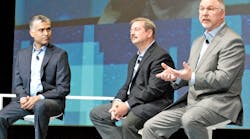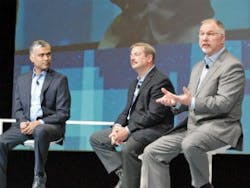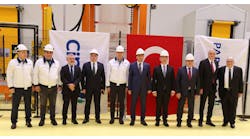Honeywell business unit leaders Ujjwal Kumar of Honeywell Measurement & Control (left), Tim Lee of Honeywell Thermal Solutions (center) and Ed Myszka of Honeywell Smart Energy (right) discussed how the company’s increasingly connected asset offerings can help its customers to operate more successfully in a time of accelerating change.
Information is power. And connected assets can provide a lot of raw data that can reveal some useful information. Annemarie Diepenbroek, global marketing director—products at Honeywell Process Solutions led a group of Honeywell business leaders in a discussion of how to get the most value from users’ connected assets at Honeywell Users Group Americas 2019 this week in Dallas.
Ed Myszka, vice president and general manager, Honeywell Smart Energy, sees huge potential in cellular technology. A sliver of spectrum dedicated to interconnect devices is embedded in 4G technology and will eventually be in 5G. “We’ll be able to connect things with a ubiquitous blanket,” he said. “I’m looking to connect things like gas meters and water meters. It’s not the meter. It’s what we do with the data from the meter. We’re starting to add more technology capabilities, like pressure and temperature sensors. We’re putting in remote disconnect capabilities. A utility can use that to shut off power, but the value goes way beyond that. If we combine the data, we know what’s going on at the end premise.”
Myszka explained how a utility customer, let’s call her Meter Mary, looks to have more control. “The power and control of how to use energy is being directed to the consumer,” he said. “But we can extract more value by adding data. We can identify when the furnace needs a tune-up or when the filter needs to be changed.”
Myszka also explained how the meter data could be combined with data from earthquake zones, so the utility could turn off the gas supply, for example, if there were a safety concern. “From a safety perspective, that has tremendous value,” he said.
The best way to find the value in the data from connected assets is to start with the key pain points, suggested Ujjwal Kumar, vice president and general manager, Honeywell Process Measurement & Control. “We have end-to-end solutions, which allows us to offer holistic, optimized solutions,” he explained. “We have a wide portfolio of software and products that allow us to solve your problems in a way not many companies can do. Some of our customers are even creating a brand new revenue stream for themselves by creating new service businesses.”
For Tim Lee, vice president and general manager, Honeywell Thermal Solutions, speed is a key enabler and driver. “Three years ago, I would have said our digital strategy was to make sure our sales people had laptops and smartphones. Now we’re looking at how to improve safety and increase productivity with connected technologies.”
Connectivity creates value
Diepenbroek asked the group to expand on how their respective groups were helping customers to realize the greatest value by collecting data from connected assets.
“We make burners for thousands of different applications,” explained Lee. His group helps customers to get the most from their assets, determining, for example, where to put the burner or what air-to-fuel ratio to use to optimize its efficiency.
With many workers nearing retirement and taking their domain knowledge with them, Lee’s group has found more opportunities to assist with tactical and strategic recommendations. “There’s an automotive plant in Ohio,” he explained. “All of the vehicles you came in, there’s a likely chance that my burners dried the paint on your vehicles.”
Lee went on to explain that a veteran worker at that plant in Ohio, named Burner Bob, had recently retired and taken his domain knowledge with him, leaving the plant personnel clueless on what to do. So Honeywell stepped in with its expertise to keep the operation going.
“Fifty percent of skilled labor is going to leave in the next seven years,” said Lee. “How do we get the information out of those people before they leave? How do we bridge that gap of domain knowledge? We can come in as Honeywell and replace that knowledge.”
Myszka suggested introducing the concept of journey mapping by taking various personas in the operation and walking through what’s important to them on a daily basis. “In the utility space, we’re going through some massive disruption due to changes in the grid,” he explained. “A third of our energy is now being driven by renewables. That’ll be more than 50% in the next five years. You can stand up a wind farm in five to seven years or a solar farm in three to five years.
With these innovations comes significant complexity, Myszka said. ”These changes drive more data points to the grid, which increases the challenges faced by a utility operator trying to deal with them.” Add in an expanding array of decentralized assets, and it becomes more difficult to extract the data and turn it into intelligence.
“Honeywell can help,” he added. “We know how to control distributed assets and extract value, too.”





